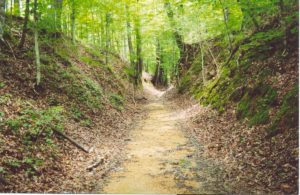Luck Is Why I’m Here – 52 Ancestors # 11
I think all of us can say that luck is how we got to be here. Our ancestors chose to do something or go someplace, and survived so that they had descendants. I have written earlier the story of my g-g grandfather Minor who spent one season as a young man cutting firewood for the steamboats on the Mississippi, somewhere near Natchez. I have also mentioned very briefly that one of my ancestors took flat boats down the river to take farm goods to sell in New Orleans in the 1800s. I am also lucky that I recently was able to take a week-long paddle-wheel boat cruise down the lower Mississippi River (no, not a gambling boat!) and actually see for myself some of the sites my ancestors might have seen.
John Salt, my third great grandfather, had a farm in southeastern Ohio (in Clermont county) and raised animals and grain. He took farm products (barrels of pork, lard and some grains like oats) by flatboat down the Ohio and then Mississippi Rivers to New Orleans to sell. Once he reached New Orleans he took the flatboat apart and sold the wood as well. The family story is that he did this by flatboat (no steam power) and then would walk back home from New Orleans. The family story also says that he did this round trip 52 times – which seems like it might be a bit of an exaggeration to me. The river distance from his starting point on the Ohio River to the joining with the Mississippi River in Illinois is about 550 statute miles. From that point to New Orleans is about another 860 miles. So the total down river distance John had to travel was about 1410 miles.
The distance for the walk back is more difficult to figure since there is no good family story of the route John would have followed. I was told by the “Riverlorian” on our recent trip that the walk back would likely have taken at least a month on foot. Since I would think that John would have been unlikely to make such a long trip during the growing season, I don’t see how he would have done more than one (but maybe two) round trips a year. I have a few partial records of the fact that he made trips in the 1840s (or shipped goods), but it is quite likely that he was transporting goods to sell from long before, perhaps as early as the 1820s but certainly by the 1830s.

The walk back home was not only physically taxing, but also likely to be dangerous. Although a horse could be purchased and ridden home, most often the returning travelers did not spend money (cash) for a horse but wanted to take the hard money home to provide things for the family for the year. Robbers and highwaymen knew that travelers north were likely to be carrying a good amount of cash and they were eager to take it away from the traveler. The Natchez Trace might have been part of the route that John would likely have traveled, and perhaps it offered some chance to band together with other travelers. The Trace ran from Natchez, Mississippi to Nashville, Tennessee, roughly 440 miles, a path through a diverse terrain that included swamps as well as rivers and while no true mountains there were hills and valleys. Today the Natchez Trace Parkway is a highway that is part of the National Parks Service and there are parts of the Old Trace that can be hiked. This picture is of a sunken portion of the Old Trace path – it should be remembered that the big old trees had all been cut down in the 1800s so the forest isn’t as thick as it would have been when the flatboaters were hiking back north with cash in their packs.

Leave a Reply